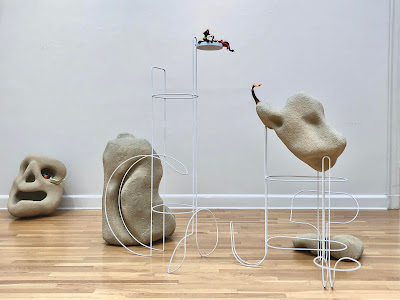"An idea is just the shape of a flower" is a solo exhibition of new work by Blas Isasi, visiting assistant professor of sculpture at Tulane. The exhibition will be on view at The Front from August 13 through September 4, 2022. nolafront.org
The Peruvian coast consists of a long and narrow strip of desert squeezed between the Andes mountains and the Pacific Ocean, and crossed by a series of oasis-like river valleys. Given its long history of human occupation, ancient ruins have been one of this arid landscape´s most emblematic features. Abandoned temples and settlements that were gradually reclaimed by the desert sands were then turned into venerated shrines and cemeteries by subsequent kingdoms and their societies. After the Spanish conquest of Peru, this continued under new forms as those practices became more syncretic (e.g. witchcraft), together with the then nascent and still ongoing looting of tombs and temples. The latest development in this long history is the commodification of the past under a neoliberal regime that renders ancient artifacts and archeological sites as tourist attractions: inert, sterilized and “disenfranchised” relics of the past. Peru´s coastal desert is a scarred landscape, one whose scars work as mnemonic devices and indexical marks. Past and present populations have systematically engaged in a complex, dynamic and often conflictive process of negotiating memory through an editing process that sometimes involves the erasing of these marks, others their unearthing, resignifying and reinvention altogether resulting in a living palimpsest.
Following in the footsteps of numerous past Peruvian artists like Emilio Rodríguez Larraín, Juan Javier Salazar, and most notoriously Jorge Eduardo Eielson in making the desert a subject of their work, in "An idea is just the shape of a flower" I try to bring into play different key aspects, fragments, materials and symbols characteristic to this unique cultural landscape. By deploying various strategies, I intend to animate some of its most representative elements such as sand, clay, bones, etc. so as to put them in dialogue with each other in ways that seem counterintuitive, suggesting not only new connections and meanings but also other possible worlds. The accompanying presence of seamless metal structures in my installations hint to cartesian reason on the one hand, while evoking 20th century Modernist design on the other, the quintessential aesthetics that symbolizes the unfulfilled promise of progress in the context of the Global South. The resulting tension from the juxtaposition of these seemingly opposing sets of elements is meant to, in the words of Raymond Williams, convey a “structure of feeling”: the feeling of things before we are able think them; the feeling of a different world before we can imagine it. In short, mine is a humble attempt to reenchant the world and sow the seeds of hope in a bleak and perilous age.
Last but not least, this exhibition is meant as a heartfelt and critical homage to the arid and stunningly beautiful land I grew up on.

No comments:
Post a Comment
Note: Only a member of this blog may post a comment.